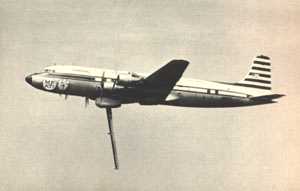|
And is it best broiled |
 | |
|
In the 60's thru 1968, there were two DC-6AB aircraft based at the Purdue University Airport in West Lafayette, Indiana. These aircraft, their logistical support hangar, and a suite of two-inch video tape duplicating equipment housed in a basement location of the Stewart Center were the "Midwest Program on Airborne Television Instruction", Inc.(MPATI) The effort was begun as a three-year experiment in 1960, with MPATI beginning the task of organizing, producing, and broadcasting instructional television with seed-money from the Ford Foundation. This was a nonprofit organization of educators and television producers who pioneered instructional television for purposes of enriching education in the wide audience of the public schools throughout the midwest in days when satellite television transmission was yet a pipe dream. By 1963, MPATI moved into its second phase where it relied totally on membership fees but it was never financially stable. MPATI found it difficult to get enough member schools to finance the organization. In its third reorganization, MPATI, unable to meet its expenses through membership fees, ceased producing and broadcasting courses in 1968 and became a tape library. The line-of-sight problem that only allowed broadcasters to send signals from ground-based transmitters to ground-based receivers plagued early television. Yet in 1944, Westinghouse engineer Charles Noble discovered a solution to this problem. A plane flying at 25,000 feet could "see" with a radius of 225 miles which was twenty times more than ground transmitters. Noble's idea was to equip planes with broadcast equipment that would allow them to transmit signals to a larger audience. Westinghouse patented this concept as Stratovision. One of the two aircraft would go aloft for six to eight hours at a time; take up a twenty minute figure-eight station centered over Montpelier, Indiana (35 miles north of Muncie, Indiana) at an altitude of 23,000 feet. From this height the range of transmission was approximately 200 miles in diameter; coverage of both the Chicago and Detroit metropolitan areas. When on station the plane would reduce speed, and then lower a forty-foot antenna mast which was gyroscopically stabilized so that the antenna always aligned from the aircraft to the center of the earth. Guess they were very concerned about polarization of the signals from these planes! Side-lobe characteristics of the antenna were tricky and reception was optimized by placing the reception antenna as near as practical to the ground and pointing it toward the Montpelier location... Programming from the planes was totally canned; taped classroom instruction, test patterns and slates with canned music backing up the video. The song playing on your sound card is one of several songs I fondly remember hearing when viewing either snowy picture of KS2XGA or KS2XGD channels 72 and 76 UHF respectively. The television equipment and transmitters were powered by a gas-turbine electrical set in the aft end of the fuselage; sort of an early APU, I guess.
Click Here for Background Information on Discovery of MPATI
see 'bout... Bucky Terranova, Webmaster ©1999 - 2003
| ||